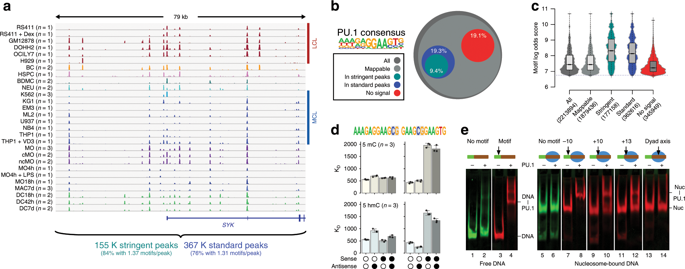当前位置:
X-MOL 学术
›
Nat. Commun.
›
论文详情
Our official English website, www.x-mol.net, welcomes your
feedback! (Note: you will need to create a separate account there.)
Mechanisms governing the pioneering and redistribution capabilities of the non-classical pioneer PU.1.
Nature Communications ( IF 14.7 ) Pub Date : 2020-01-21 , DOI: 10.1038/s41467-019-13960-2 Julia Minderjahn 1 , Andreas Schmidt 2 , Andreas Fuchs 3 , Rudolf Schill 4 , Johanna Raithel 1 , Magda Babina 5 , Christian Schmidl 6 , Claudia Gebhard 1, 6 , Sandra Schmidhofer 1, 7 , Karina Mendes 1 , Anna Ratermann 1, 8 , Dagmar Glatz 1, 9 , Margit Nützel 1 , Matthias Edinger 1, 6 , Petra Hoffmann 1, 6 , Rainer Spang 4 , Gernot Längst 3 , Axel Imhof 2 , Michael Rehli 1, 6
Nature Communications ( IF 14.7 ) Pub Date : 2020-01-21 , DOI: 10.1038/s41467-019-13960-2 Julia Minderjahn 1 , Andreas Schmidt 2 , Andreas Fuchs 3 , Rudolf Schill 4 , Johanna Raithel 1 , Magda Babina 5 , Christian Schmidl 6 , Claudia Gebhard 1, 6 , Sandra Schmidhofer 1, 7 , Karina Mendes 1 , Anna Ratermann 1, 8 , Dagmar Glatz 1, 9 , Margit Nützel 1 , Matthias Edinger 1, 6 , Petra Hoffmann 1, 6 , Rainer Spang 4 , Gernot Längst 3 , Axel Imhof 2 , Michael Rehli 1, 6
Affiliation

|
Establishing gene regulatory networks during differentiation or reprogramming requires master or pioneer transcription factors (TFs) such as PU.1, a prototype master TF of hematopoietic lineage differentiation. To systematically determine molecular features that control its activity, here we analyze DNA-binding in vitro and genome-wide in vivo across different cell types with native or ectopic PU.1 expression. Although PU.1, in contrast to classical pioneer factors, is unable to access nucleosomal target sites in vitro, ectopic induction of PU.1 leads to the extensive remodeling of chromatin and redistribution of partner TFs. De novo chromatin access, stable binding, and redistribution of partner TFs both require PU.1's N-terminal acidic activation domain and its ability to recruit SWI/SNF remodeling complexes, suggesting that the latter may collect and distribute co-associated TFs in conjunction with the non-classical pioneer TF PU.1.
中文翻译:

控制非经典先驱PU.1的开拓和再分配能力的机制。
在分化或重新编程过程中建立基因调控网络需要掌握转录或先驱转录因子(TF),例如PU.1,即造血谱系分化的原型掌握TF。为了系统地确定控制其活性的分子特征,在这里我们分析具有天然或异位PU.1表达的不同细胞类型在体外和全基因组体内的DNA结合。尽管与经典先驱因子相比,PU.1无法在体外访问核小体靶位点,但异位诱导PU.1导致染色质的广泛重塑和伴侣TF的重新分布。从头获得染色质,稳定地结合和伙伴TF的重新分布都需要PU.1的N端酸性激活结构域及其募集SWI / SNF重塑复合体的能力,
更新日期:2020-01-22
中文翻译:

控制非经典先驱PU.1的开拓和再分配能力的机制。
在分化或重新编程过程中建立基因调控网络需要掌握转录或先驱转录因子(TF),例如PU.1,即造血谱系分化的原型掌握TF。为了系统地确定控制其活性的分子特征,在这里我们分析具有天然或异位PU.1表达的不同细胞类型在体外和全基因组体内的DNA结合。尽管与经典先驱因子相比,PU.1无法在体外访问核小体靶位点,但异位诱导PU.1导致染色质的广泛重塑和伴侣TF的重新分布。从头获得染色质,稳定地结合和伙伴TF的重新分布都需要PU.1的N端酸性激活结构域及其募集SWI / SNF重塑复合体的能力,











































 京公网安备 11010802027423号
京公网安备 11010802027423号